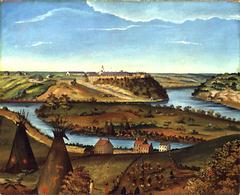Curriculum Materials: Art in America
|
|
Image 7 Edward K. Thomas Questions: |
View of Fort Snelling
Thomas sketched the fort and surroundings from the elevated vantage point of Pilot's Knob, shown in the painting's FOREGROUND. The hill rises above the village of Mendota (in the MIDDLEGROUND), which overlooks the rivers to the south. Also in the foreground are two tepees and a group of Dakota Indians dancing around a pole.
In the middleground stand several buildings, including two of Minnesota's earliest stone houses, which still exist today. On the far left is a two-story building constructed in 1839 by Jean Fairbault, founder of Mendota. To the right, in front of a two-story warehouse, is the home of Henry Sibley, an agent for the American Fur Company and later territorial governor of Minnesota. To the far right is the warehouse of the American Fur Company (no longer standing). Also in the middleground, the Minnesota River sweeps around Pike Island to meet the Mississippi. Identified by the U.S. flag, the fort complex stands in the BACKGROUND. Visible are several buildings organized around a parade ground surrounded by a high stone wall.
Though untrained, Thomas intuitively used several devices to create some sense of depth in his painting. He showed objects in the foreground larger than those further back and, using ATMOSPHERIC PERSPECTIVE, he showed the most distant parts in bluer shades. The artist arranged the land masses and the winding line of the river to draw the viewer's eye back to the high HORIZON LINE. Nonetheless, the painting still appears fairly flat because Thomas used very little MODELING in dark and light to indicate volume. Also, counter to the way we actually see, he rendered every aspect of the painting with the same amount of detail regardless of its place in the scene.
While Thomas's description of
details of the land and buildings is accurate, his
characterization of the Dakota Indians in the foreground is
inaccurate. Many European Americans believed that the
American Indians were less civilized than they themselves.
This pervasive attitude encouraged stereotypical
representation of Indians in art, including this painting.
By showing the Dakota dancing around a pole bearing enemy
scalps, Thomas suggested that this
was a part of their daily life, which it was not. Further,
he showed the dance as threatening when, in fact, the Dakota
would have performed such a dance to ask forgiveness of the
other Indians they had killed. Thomas
also misrepresented the tepees and the men's clothing to
make the picture more appealing. For example, he showed all
the dancers wearing long feather headdresses, which in
reality only a few highly honored men could wear. While
images like these may have helped
Thomas sell more paintings, they also
contributed to damaging stereotypes.
|
|
